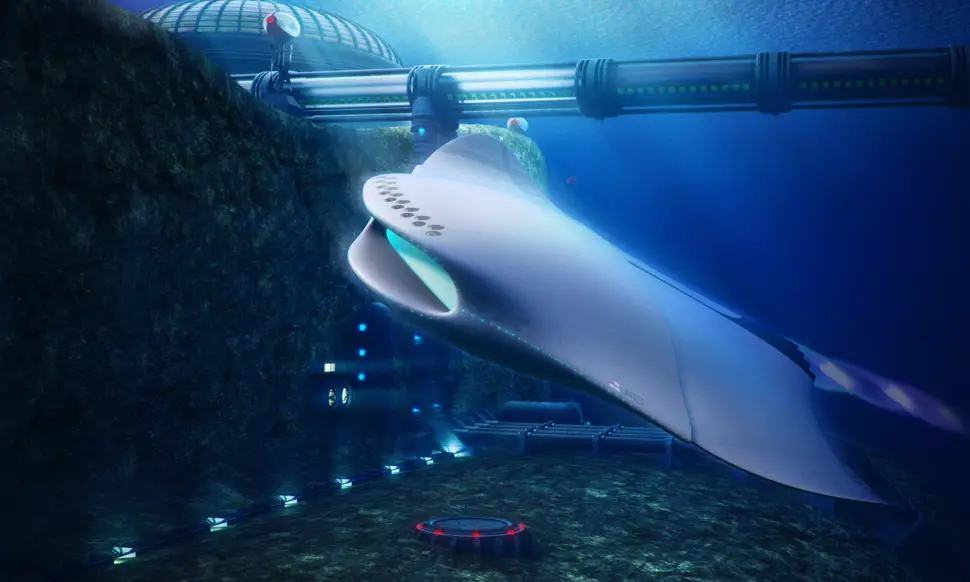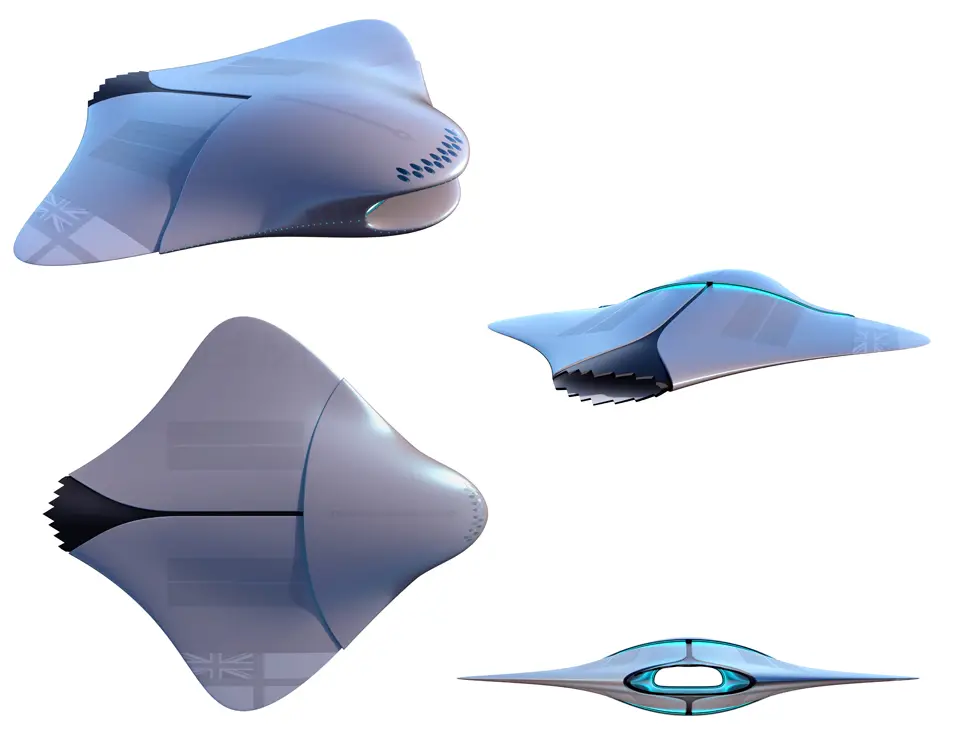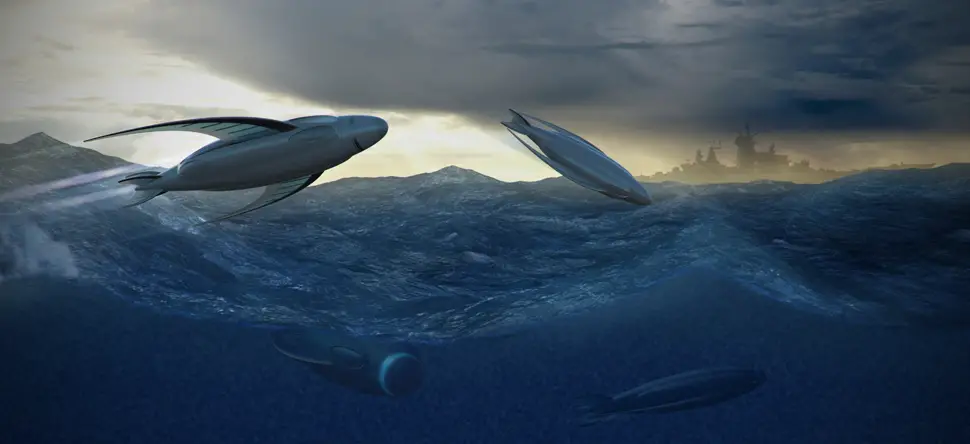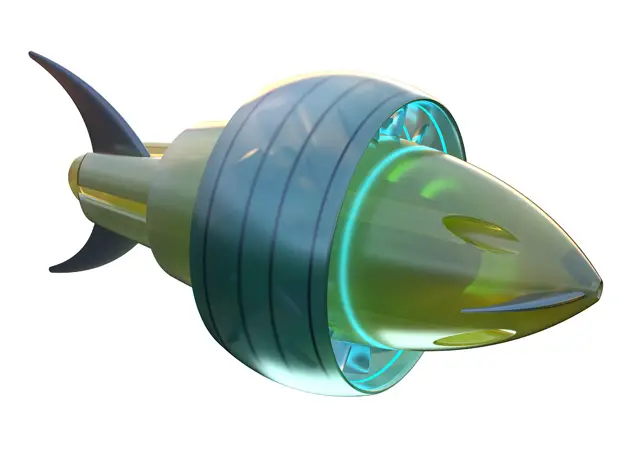
21st September 2017 What will submarines look like in 50 years? Concept designs for submarines of the 2060s have been revealed by Britain's Royal Navy.
The Royal Navy has unveiled a series of futuristic submarine concepts that mimic real marine lifeforms and could radically change the way underwater warfare is conducted in 50 years. With a crewed mothership resembling a manta ray, unmanned eel-like vessels equipped with sensor pods that dissolve on demand to avoid detection, and fish-like torpedoes that swarm against enemy targets, these concepts aim to inspire the world's future underwater combat environment. The UK's brightest and most talented young engineers and scientists came up with the designs, after being challenged by the Royal Navy to imagine what a future submarine would look like and how it would be used to keep Britain safe in decades to come. "These remarkable designs display the great promise of our young engineers and scientists and the great ambition of the Royal Navy," Defence Minister Harriett Baldwin said. "This kind of innovation is at the heart of defence and the UK's world-leading capability. That's why we are using our rising budget to invest in high-tech capability to keep our Armed Forces at the cutting-edge, and our £800 million Innovation Fund aims to take advantage of exactly these kinds of futuristic ideas." The mothership would be built from super-strong alloys and acrylics, with surfaces able to morph and change shape. With hybrid algae-electric cruising power and propulsion technologies including tunnel drives working similarly to a Dyson bladeless fan, these submarines could travel at unprecedented speeds of up to 150 knots.
"With more than 70 per cent of the planet's surface covered by water, the oceans remain one of the world's great mysteries and untapped resources," said Commander Peter Pipkin, the Royal Navy's Fleet Robotics Officer. "It's predicted that in 50 years' time, there will be more competition between nations to live and work at sea, or under it. So it's with this in mind that the Royal Navy is looking at its future role, and how it will be best equipped to protect Britain's interests around the globe. "Today's Royal Navy is one of the most technologically advanced forces in the world – and that's because we have always sought to think differently and come up with ideas that challenge traditional thinking. If only 10 per cent of these ideas become reality, it will put us at the cutting edge of future warfare and defence operations." The project – named Nautilus 100 – was set up to mark the 100th anniversary of the launch of USS Nautilus. Rear Admiral Tim Hodgson, the Ministry of Defence's Director of Submarine Capability, commented: "We want to encourage our engineers of the future to be bold, think radically and push boundaries. From Nelson's tactics at the Battle of Trafalgar to Fisher's revolutionary Dreadnought battleships, the Royal Navy's success has always rested on a combination of technology and human skill. "The pace of global innovation is only going to increase, so for the UK to be a leader in this race it needs to maintain its leadership in skills and technology. Hopefully this project has inspired the next generation of British scientists to be bold in their ambitions and I congratulate them for their inspiring work."
Young British scientists and engineers from UKNEST, a not-for-profit organisation which promotes science, engineering and technology for naval design, answered the challenge. More than 20 of them took part in the project, 'visioneering' a new submarine fleet for the future Royal Navy. Gemma Jefferies, 21, from Bristol, an engineering assistant with L3 Marine Systems UK, said: "It was amazing to see a whole manner of disciplines coming together in this project. It was great to let our imaginations run with crazy ideas – some that may not actually be considered science fiction in the near future." The young engineers behind Project Nautilus 100 visualised a future submarine with a whale shark-styled mouth and manta ray body, allowing a combination of speed and stealthiness unmatched by today's technology. Its 3D-printed hull would be a combination of light but super-strong materials capable of withstanding extreme pressures at depths of 1000m or more. This mothership would have a reduced crew of around 20 people, capable of brain-computer control of the submarine's command system. There would be two propulsion systems – one for silent and efficient cruising for thousands of miles at up to 30 knots, and the other for short bursts of high speed in a 'fight or flight' scenario. A recovery bay in the underside would act as a docking station for the transfer of people, payloads and general stores. Weapons bays would be integrated into the top of the submarine, holding a variety of weapons and sensors, plus conventional torpedo tubes for self-defence decoys able to be 3D-printed on board. Unlike the submarines of today, which perform multiple roles in one hull, it is envisaged that the Royal Navy of the future would operate a family of submarines of various shapes and sizes, both manned and unmanned, to fulfil a variety of tasks.
Unmanned Underwater Vehicles (UUVs) shaped like eels would be the main sensors and secondary weapons carriers launched from the weapons bays on top of the mothership. Capable of total autonomy, these could travel hundreds of miles in near silence, using an eel-like sine wave propulsion motion to disguise them as real marine lifeforms in the eyes of an enemy's sensors. Their main purpose would be to eject individual sensor pods, each using blue-green laser energy to communicate, forming a self-meshing underwater network with secure command and control hundreds of miles apart. These multi-purpose sensors would also listen for residual sound energy or electro-magnetic disturbances, sharing vast amounts of data using AI to provide battle-winning automated assessment and decision-making.
Alongside these UUVs would be a variety of micro drones (pictured below). Made from cold saltwater-soluble polymers like the liquid capsules used in your washing machine, they could be released in blooms, and communicate with each other and the eels, providing detail reconnaissance of targets. The pods could produce a constant supply of sensors and drone swarms via 3D printers, which would gather biological material from the ocean and use it to build new sensors. These micro drones could play a role in escort duties when the Royal Navy is required to shadow foreign submarines or vessels detected in British waters. The micro drones would follow and escort them until they were back in international waters. They would be engineered to dissolve after a predetermined period of time – so if deployed in enemy waters, they would be undiscovered. The drones would also have adhesive properties in their semi-dissolved state, and could be directed to enemy ships to block their uptakes and intakes, rendering the vessels inoperative.
---
Comments »
|












